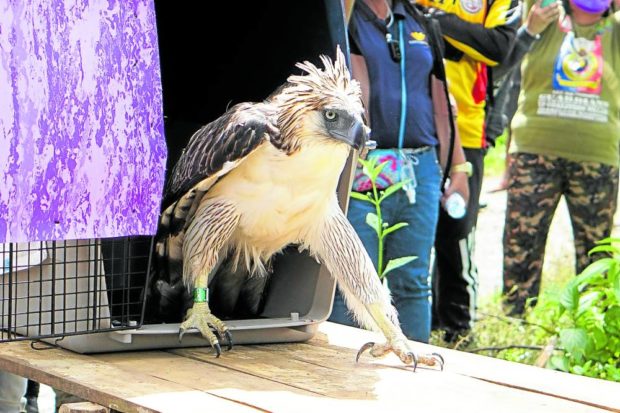
RELEASED A Philippine eagle rescued from wildlife hunters is released in Lingig, Surigao del Sur, in November after its seven-month rehabilitation. —ERWIN MASCARIÑAS.
DAVAO CITY, Davao del Sur, Philippines — Conservationists believe printing the image of the Philippine eagle (Pithecophaga jefferyi) on the P1,000 bill will help raise awareness about the national bird, but they would like to see more meaningful government action toward its protection.
The decision of the Bangko Sentral ng Pilipinas (BSP) to replace the images of wartime heroes Josefa Llanes Escoda, Jose Abad Santos, and Vicente Lim with the Philippine eagle has recently stirred a controversy.
First, with the wrong spelling of the bird’s scientific name, and then on the propriety of taking out the images of national heroes who fought against the Japanese occupation of the country during World War II, raising suspicion they are deliberately being obliterated from historical memory.
Senatorial aspirant Emmanuel Piñol, a former secretary of agriculture, also took issue with the change of material, from abaca fiber to polymer plastic, saying this should have gone through a consultation, including the design and the images in the currency.
Awareness
Printing the eagle on the P1,000 bill “will probably help promote recognition and awareness of our national bird. Now, whether that translates into active involvement and participation in the conservation effort for the species is something we have yet to see,” said Dennis Salvador, executive director of the Philippine Eagle Foundation (PEF).
Salvador said the foundation was not consulted by the BSP about its decision to feature the national bird on the P1,000 bill.
The PEF operates the Philippine Eagle Center in Malagos village, undertaking captive breeding of the raptors as well as rehabilitating those victimized by human activities and rescued from communities.Since 1987, the PEF has run a conservation program for the national bird. In 1992, its captive-breeding work resulted in the hatching of the eagles Pag-asa (Hope) and then Pagkakaisa (Unity), a breakthrough in eagle conservation.
Last Dec. 4, the 29th chick was hatched at the Malagos facility, and on Nov. 17, the PEF released the fifth of 10 eagles rescued and rehabilitated since the onset of the pandemic.
Funding, policies
“Coming into our 35th year of conservation efforts for the species, we have yet to see meaningful and significant support from our national government to take our national bird off the critically endangered species list,” Salvador said.
“Beyond putting significant funding into this effort, we need to have policies aligned toward this goal, real enforcement (of environment laws) has to take place, antipoverty programs to actually reach people in and around the forest, and others,” he added.
Dr. Jayson Ibañez, the PEF’s director for research and conservation, told the Inquirer that currently, the increase in wildlife hunting, especially during the pandemic, had increased the immediate threat against the raptor.
Ibañez called for vigorous efforts to enforce environmental laws and conduct community education to raise awareness about the ecological importance of the raptor, hence drawing support for its protection. He particularly pointed to the need to deploy more forest guards.

